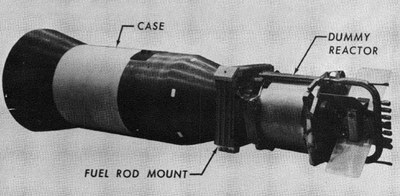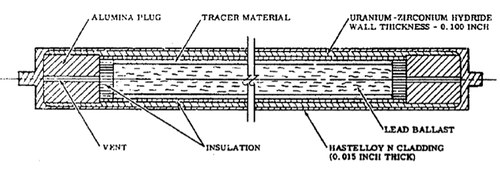In rod we trustby Michael A. Shoemaker
|
| NASA actually conducted several atmospheric reentry flight tests of, essentially, inanimate rods. |
First, the joke needs explaining. The uninitiated are also referred to the episode descriptions that can be found on the web. Although this episode is 17 years old, those sensitive to spoilers should be warned. A recurring gag in the episode involves Homer being upstaged by the above-mentioned inanimate carbon rod. In the beginning of the episode, the rod is the recipient of the “Worker of the Week” award at the nuclear power plant where Homer works (despite the fact that Homer is the only person yet to receive the reward). This disappoints Homer, and later in the episode he is so bored by a televised shuttle launch that he calls NASA to complain. Coincidently, NASA is looking to boost its popularity by selecting an “average Joe” to take part in a shuttle flight. Eventually, Homer ends up in orbit, and because of a mishap involving potato chips and microgravity, the Shuttle’s exterior hatch is broken. Unless the crew can secure the hatch for reentry, they are all doomed.
In another twist of fate, Homer accidently breaks of a rod from the shuttle interior, which lodges in the hatch and secures it shut. If the rod holds, they might survive atmospheric reentry and make it back to Earth. Needless to say, Homer survives (otherwise the show would not still be on the air), along with the rest of the crew. But in another comedic twist, the rod that lodged in the shuttle hatch is heralded as the true hero of the mission—Homer is again upstaged by an inanimate carbon rod. The cover of Time magazine shows a portrait of the rod with the headline “In Rod We Trust”.
While the reader may be familiar with this episode of The Simpsons, it may come as a surprise that NASA actually conducted several atmospheric reentry flight tests of, essentially, inanimate rods!
Although nuclear power sources for spacecraft have become scarce these days, the situation was different in the 1960s. The nuclear generators like the Systems for Nuclear Auxiliary Power (SNAP) were being designed by the Atomic Energy Commission and NASA, with projected applications including weather, communication, military, and interplanetary spacecraft. The SNAP-10A consisted of a uranium-zirconium hydride reactor2. The SNAP-19 was a radioisotope thermoelectric generator with plutonium-238 fuel, meant to supply electric power to the NIMBUS-B weather satellite 3. This author is sure that Homer Simpson is quite familiar with these sorts of devices from his work at the nuclear power plant.
| There is a connection between the RFD tests from the 1960s and NASA’s current computer codes for predicting the survival or demise of reentering satellites and space debris. |
In case these nuclear generators accidentally reentered the Earth’s atmosphere before the fuel was spent, they were designed to disassemble in the early stages of reentry and expose the fuel capsules to enough aerodynamic heating that any radioactive materials would not survive to the ground. In the words of one report3: “It has been determined from theoretical analysis that, in the process, any hazardous materials would be ablated into a fine particulate which would become suspended and dispersed safely in the upper atmosphere.”
Although theoretical analysis is nice, they decided that flight testing was required. As summarized in one paper4:
Sandia Corporation, in the 1960s, conducted flight tests… in which fuel rod models were ejected from a reentry vehicle after being launched into a sub-orbital trajectory with a NASA Scout rocket. The simulated fuel rods consisted of cylinders with walls of various thicknesses and an optical tracer material in the cylinder core. During entry, the fuel rods were tracked by optical instruments and the time at which the tracer material was observed was identified. These data provide an indication of the altitude at which the cylinder walls have ablated and the tracer material was exposed.
Figure 1 shows a photo of the RFD-1 reentry vehicle. The rear of the vehicle was designed to survive reentry, because it housed data-recording and telemetry equipment. The prototype of the SNAP reactor is attached to the front of the vehicle, from which the fuel rods were released. Perhaps it should be noted that the fuel rod models in these tests were not radioactive: they consisted of inert tracer materials like thallium, silver, indium, and strontium. The distinct emissions from these tracer materials were then observed by spectrographs and other optical sensors located near the reentry zone. Figure 2 shows a sketch of the RFD-1 fuel rod model.
 Figure 1: RFD-1 test vehicle2. |
The first of these reentry test flights, which was launched on May 22, 1963, from NASA Wallops in Virginia, was given the creative name “Reentry Flight Demonstration Number 1” (RFD-1). (Perhaps RFD could also stand for “Rod Flight Demonstration”?) The suborbital launch vehicle reached an altitude of almost 500,000 feet (150 kilometers), with the fuel elements ejecting from the simulated SNAP-10A generator at around 375,000 feet (115 kilometers). The tracer flares from the fuel rod models were visible at an altitude of around 200,000 feet (60 kilometers), and lasted for about one minute. The second flight test, this time for the SNAP-19 generator, occurred on October 9, 1964, and was given the equally creative name RFD-2. Reportedly, these artificial, suborbital meteors were even visible with the naked eye from Bermuda3.
 Figure 2: RFD-1 fuel rod model4. |
These RFD tests were claimed as an overall success, because the fuel rod models ablated as predicted. Yet, the testing and simulation of reentering nuclear fuel rods has been an ongoing area of research, because all US space missions that include a nuclear power source must assess the potential risks to people and the environment5. (In fact, with research paper titles like “Ablation of Graphitic Materials in the Sublimation Regime”6, it is reasonable to assume that at least some of this research involved inanimate carbon rods). This sort of testing is challenging for interplanetary spacecraft that perform Earth gravity assists; it is difficult to simulate the possible reentry of a body at hyperbolic speeds using lab experiments or flight tests. Many readers may remember the anti-nuclear protests concerning the launch of such spacecraft, like Cassini-Huygens. Apparently these protesters did not have faith in the rod.
Lastly, it is interesting to note that there is a connection between the RFD tests from the 1960s and NASA’s current computer codes for predicting the survival or demise of reentering satellites and space debris. The Object Reentry Survival Analysis Tool (ORSAT), developed by NASA and Lockheed Martin, has been used to predict the ground impact risk of many objects that may reenter the atmosphere in the future7. The data from the RFD fuel rods were one of the few sources that allowed verification of the ORSAT code using actual flight data4,8.
So next time you look up at the stars and wonder if a stray nuclear generator or spent rocket body will fall on your head, you should remember the sacrifices made by all of these inanimate carbon rods in the name of science.
References:
- From D. Mirkin, 2004, The Simpsons season 5 DVD commentary for the episode "Deep Space Homer", DVD, 20th Century Fox. (Author note: I am trusting the citation from Wikipedia, because I do not have a copy of this DVD myself).
- Anonymous, “Nuclear Safety Research and Development Program – Summary Report”, Technical Report from the U.S. Atomic Energy Commission, 1 Nov, 1964, Report No. WASH-1052, doi:10.2172/4660550.
- Anonymous, “Systems for Nuclear Auxiliary Power – An Evaluation, January 1964”, Technical Report from the U.S. Atomic Energy Commission, 31 Oct, 1964, Number No. TID-20079, doi:10.2172/4079666.
- S. Bouslog, B. Ross, C. Madden, “Space Debris Reentry Risk Analysis”, Proceedings of the 32nd AIAA Aerospace Sciences Meeting and Exhinit, Jan., 1994, Reno, NV, AIAA Paper 1994-0591.
- S. Lutz, C. Chan, “Ablation Response Testing of Simulated Radioisotope Power Supplies”, Journal of Spacecraft and Rockets, Vol. 31, No. 3, 1994, pp. 489-492, doi:10.2514/3.26465.
- J. Lundell, R. Dickey, “Ablation of Graphitic Materials in the Sublimation Regime”, AIAA Journal, Vol. 13, No. 8, 1975, pp. 1079-1085, doi:10.2514/3.60505.
- W. Rochelle, J. Marichalar, N. Johnson, “Analysis of reentry survivability of UARS spacecraft”, Advances in Space Research, Vol. 34, 2004, pp. 1049-1054, doi:10.1016/j.asr.2003.01.011.
- R. Smith, et al., “Reentry Survivability Analysis of the Hubble Space Telescope (HST)”, Proceedings of the 4th European Conference on Space Debris, Darmstadt, Germany, Apr., 2005, ESA SP-587.
